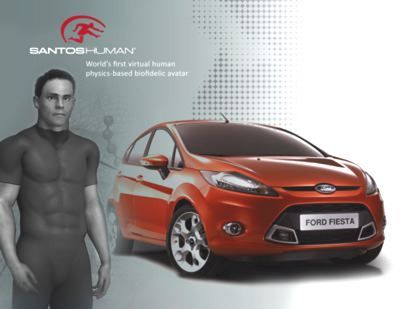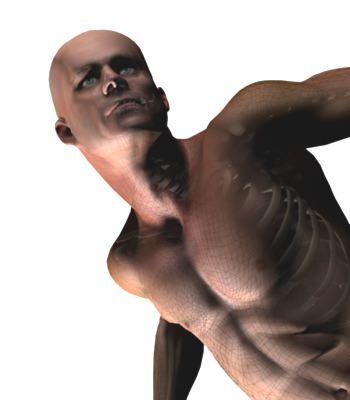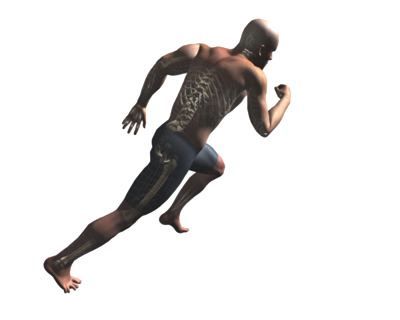The newest member of the Ford->ke31 family is a military man ready to tackle his job and provide all of the information he can about his co-workers. No, we are not talking about a company snitch. We are talking about Santos, is a virtual worker that was originally created for the U.S. Department of Defense at the University of Iowa. Ford Motor Company has decided that this soldier would be the perfect candidate to provide information on the physical strains put on the human body while working on the assembly line. His credentials are bar none. He was part of the Virtual Soldier Research (VSR) program at the university and his job was to execute tasks and then record the strains in the body in his computer brain. Santos can reach, lift, and stretch. He can walk, talk, and answer questions. We picture him a tad like Robin Williams in Bicentennial Man. He is basically a robot with a complete biomechanical muscular system to provide feedback on fatigue, speed, strength, but without the emotions attached to it.
"Creating the safest and most ergonomic way to build a vehicle is a trial-and-error process – in recent years technology has allowed this process to happen in the virtual world," said Allison Stephens, ergonomics technical specialist with Vehicle Operations Manufacturing Engineering. "Santos takes this to a new level. He can perform a task and tell us whether over months and years it will cause back strain, for example, and we can make adjustments until we find the optimal way to get the job done."
Full story and press release after the jump.
Ford has been working with the University of Iowa three years ago with GM and Chryskler jumping on board as well. The three automotive groups have paid out $500,000 in the past three years to continue this research. The research has also received $10 million toward development from the federal government.
"This software is a new experience – you can get feedback. You can see body strength in real time. You can see fatigue. When you have that ability to see motion, to predict motion, you can work that into your designs and programs," said Tim Marler, a VSR senior research scientist.
"The human body is amazing, and we're always learning something new," Stephens said. "The better we understand the human body, the better we can create a safer, ergonomically correct workplace."
Santos is still in his testing phase, but will soon see the light of the Ford assembly line. Although, we feel this is a huge accomplishment in learning the inner workings of the human body in order to create a safer work environment, we are a little bit curious to see if the “virtual workers” end up being the only workers. As technology forges on, will we be left in the background scrambling to keep up? Let’s just hope society can take full advantage of the technology for what it was made for because it is a very helpful tool in acquiring information.
Press Release
The new guy on the Ford Motor Company assembly line is an inexhaustible tough guy with impeccable military and academic credentials.
His name is Santos, a highly realistic virtual worker who doesn't just simulate motion; he records the actual physical strains of reaching, lifting and stretching. He can execute tasks autonomously. He can walk, talk and answer questions.
Originally created for the U.S. Department of Defense at the University of Iowa as part of the Virtual Soldier Research (VSR) program to help reduce physical strain on soldiers, Santos has been heralded by ergonomists as a breakthrough in digital modeling.
Santos' move from the virtual battlefield to the virtual assembly line is the latest step in Ford's efforts to improve ergonomics at its manufacturing plants.
"Creating the safest and most ergonomic way to build a vehicle is a trial-and-error process – in recent years technology has allowed this process to happen in the virtual world," said Allison Stephens, ergonomics technical specialist with Vehicle Operations Manufacturing Engineering. "Santos takes this to a new level. He can perform a task and tell us whether over months and years it will cause back strain, for example, and we can make adjustments until we find the optimal way to get the job done."
Santos builds on the company's use of digital avatars – dubbed Jack and Jill – that help Ford test ergonomics and safety on the assembly line in the virtual world. Santos goes further by allowing Ford to understand the true strain on the body when performing actions on the job.
"It's very cool in the ergo world that we can evaluate these types of movements, these lifts where you're using acceleration, or momentum – what we call the dynamics of a lift," Stephens said.
Santos provides feedback and realistic insight.
When Stephens heard about the research being done with Santos in VSR program, she was immediately intrigued. "The same issue is at work at Ford as in the military – how to analyze human limits with dynamic motion. Santos, with his capability in predictive dynamics, will aid in increasing efficiency as well as safety and quality."
Santos is the culmination of years of study in modeling, multi-body dynamics and robotics, said Jay Johnson, CEO of SantosHuman Inc., which works in conjunction with the University of Iowa.
"Our software uses a physics platform," Johnson said. "We can change things and see the effect; that's what predictive dynamics brings to the table."
Predictive dynamics uses general rules of human body movement combined with complex mathematical models and robotics to enable Santos to provide feedback on fatigue, speed, strength and torque, even as the parameters of the virtual environment change, said Tim Marler, a VSR senior research scientist.
The laws of physics apply
Because Santos has been equipped with a complete biomechanical muscular system, he is subject to all the laws of physics, Marler said. "This software is a new experience – you can get feedback. You can see body strength in real time. You can see fatigue. When you have that ability to see motion, to predict motion, you can work that into your designs and programs."
The Department of Defense has been working with the University of Iowa since 2004; Ford began working with the university three years ago. Stephens formed a collaboration with GM and Chrysler to share funding, with each automotive group paying $500,000 over the past three years. The federal government has put in approximately $10 million toward development.
Santos is still in the testing phase, Stephens said, but when he comes on board, he will help Ford continue to move forward in the field of ergonomics.
"The human body is amazing, and we're always learning something new," Stephens said. "The better we understand the human body, the better we can create a safer, ergonomically correct workplace."



